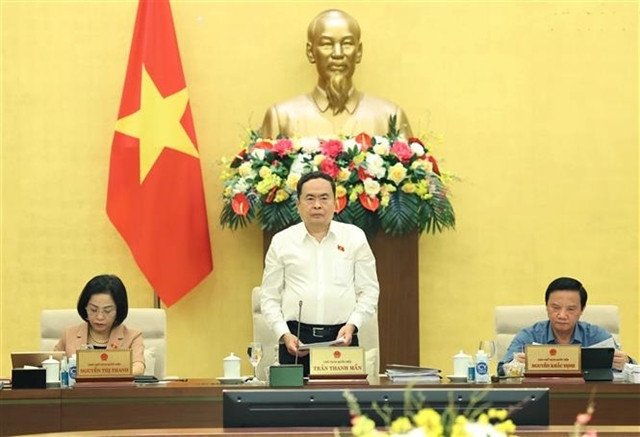 |
| National Assembly Chairman Trần Thanh Mẫn chairs the 5th thematic session on law-building on Monday morning. VNA/VNS Photo |
The National Assembly (NA) Standing Committee convened its 5th thematic session on law-building on Monday morning under the chair of NA Chairman Trần Thanh Mẫn.
In his opening remarks, the top legislator highlighted the significance of the meeting, saying that law-makers will discuss the revision of 10 out of 11 draft laws that were first submitted for debate at the NA's 7th session, including the Law on Geology and Minerals, the Law on amendments and supplements to a number of articles of the Law on Pharmacy.
They will also discuss the revised Law on Trade Unions, the revised Law on Human Trafficking Prevention and Control, the revised Notary Law, the revised Law on Cultural Heritage, the Law on Urban and Rural Planning, the Law on Fire Prevention, Fighting and Rescue, the revised Law on Value Added Tax and the Law on Juvenile Justice.
According to the NA Chairman, the NA has so far completed 131 legislative tasks, equivalent to 83.97 per cent of the workload.
He requested that the revision and finalisation of the above-mentioned laws should adhere closely to the agreed-upon viewpoints, goals, principles and directions which were included in the law and ordinance building programme approved by the NA.
Noting that at the NA's 7th session, more than 200 opinions were presented during the debate on those bills, NA Chairman Mẫn urged the Standing Committee to clearly report which issues have been addressed in the revised versions of the bills and which have not, as well as the reasons for any disagreements between reviewing bodies and drafting agencies.
He went on to say that NA committees had organised numerous seminars and workshops and conducted many surveys on the draft laws, emphasising the need to study and use the results from those events and discussions to identify the issues that need to be addressed in the finalisation of those bills.
On Monday, the Standing Committee discussed the draft revised Law on Geology and Minerals. The draft revised law consists of 12 chapters and 117 articles, amending 72 articles from the version presented at the 7th session.
In the report on the explanation, reception and revision of the draft revised law, Chairman of the NA Committee on Science, Technology and Environment Lê Quang Huy stated that for the responsibility of mineral planning (Article 15), the standing committee collaborated with the drafting agency to develop two options.
In the first option, the Ministry of Natural Resources and Environment will be assigned to prepare the mineral planning, including mineral exploration, extraction and utilisation and the option proposed by the Government.
In the second option, the Ministry of Industry and Trade and the Ministry of Construction will be assigned this task, keeping the current provisions of the Mineral Law and the Planning Law.
Most opinions agreed with the second option.
Regarding the adjustment of mineral planning (Article 16), the standing committee worked with the drafting agency to develop two options. In the first option, adjustments will be made according to planning laws. In the second option, the draft law specifies cases that do not require planning adjustments and cases that require adjustments in a simplified manner and according to mineral laws.
The two options relate to amendments to Article 46 on principles for granting mineral exploration licenses, Article 58 on principles for granting mineral exploitation licenses, Article 76 on general provisions on exploiting Group 4 minerals and Clause 5 of Article 115 on amendments to the Planning Law.
Most opinions agreed with the second option.
Speaking at the meeting, NA Chairman Mẫn emphasised that the issue of granting permits for mineral exploitation, common construction materials and fill materials in planned areas is very important. Therefore, a clear distinction between planning, exploration and exploitation is needed.
He suggested further study of the two differing options for Articles 15 and 16 of the draft law. For the issue of responsibility for mineral planning (Article 15), a thorough assessment of the policy impact is needed if the responsibility for mineral planning is shifted from the current provisions involving the Ministry of Construction and the Ministry of Industry and Trade to a centralised responsibility under the Ministry of Natural Resources and Environment.
For the adjustment of mineral planning (Article 16), he requested input from State management agencies, such as the Ministry of Planning and Investment, on whether specific regulations for the mineral sector could be set in the draft law or if these issues should be discussed when amending the Planning Law.
In particular, when drafting the law, the drafting and appraisal agencies must fully incorporate the directives of the Politburo as outlined in Resolution No 10-NQ/TW issued on February 10, 2022, which provides strategic directions for geology, minerals and the mining industry up to 2030, with a vision for 2045. — VNS